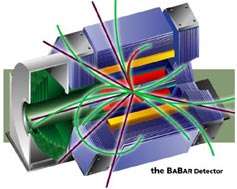The PEP-II accelerator has reached a milestone, delivering enough particle collisions for the BaBar detector to observe 500 million pairs of B and anti-B particles.
Thanks to a steady push during the course of eight years, the PEP-II accelerator has now delivered double the amount of data originally expected when the BaBar experiment first started up in May of 1999.
Between then and September 4, 2007, when Run 6 concluded, PEP-II has generated a remarkable half an inverse attobarn of integrated luminosity—a measure of the number of particle collisions in a given period of time. This corresponds to 500 million pairs of B and anti-B particles, whose decays have yielded major discoveries this decade. The sheer quantity of data is reshaping the kind of physics that can be investigated.
PEP-II's achievement is a testament to hard work, as well as continual upgrades and adjustments to a machine built with the capacity for future improvements. The accelerator now regularly operates with four times the luminosity, or collision concentration, it was designed to deliver. Higher luminosity translates into more accurate results and the ability to find otherwise unobservable physics, such as matter–antimatter asymmetry in rare "penguin" type decays.
"Many groups at SLAC have worked very hard over a long time to make luminosity high and reliability strong. We're very pleased," said John Seeman, head of the Accelerator Systems Division.
To reach half an inverse attobarn, accelerator physicists and operators needed to keep PEP-II humming stably, providing high luminosity day after day, month after month. Despite a series of challenging problems which resulted in reduced luminosity for the first half of the run, PEP-II supplied an average of just under 700 inverse picobarns per day in August, the best month of data collection ever and seven times the rate called for in the original goals.
A number of measures contributed to the success of PEP-II—the world's first storage ring to use colliding beams of different energies, which was the key to directly observing an asymmetry between B and anti-B decays. Over the years, the Accelerator Systems Division has doubled the number of radiofrequency (RF) stations that supply accelerating power to the beams; increased the amount of charge carried by the beams; improved the vacuum systems and beam focusing ability; and instigated continual beam injection, which alone accounts for a 40 percent boost in average luminosity.
Fortunately, the BaBar detector was also built with headroom—the ability to handle more data flow than PEP-II was originally expected to provide. In addition, upgrades to the triggering and other systems have enabled the collaboration to take advantage of the welcome flood of data.
"The science program at BaBar greatly expanded because of the increased luminosity and data. It has allowed a much richer exploration of matter–antimatter asymmetries than originally thought possible," said BaBar Spokesperson Hassan Jawahery.
The final run for the PEP-II/BaBar duo begins Dec. 4 and wraps up on Sept. 30, 2008.
While the one half inverse attobarn so far accumulated is a tremendous milestone for the project, plans for the 2008 run remain even more ambitious. "SLAC is committed to maximizing luminosity in the next run. A final round of upgrades being implemented this fall will position PEP-II to assault all-time records for storage ring performance," said David MacFarlane, Deputy Director of PPA.
"With a good solid run, we could add 200 to 250 inverse femtobarns to the existing 500 (the same as half an inverse attobarn). We're aiming for 50 percent more data in one year," Seeman said.
Source: by Heather Rock Woods, Stanford Linear Accelerator Center
























